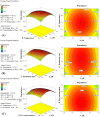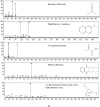A feasible approach for azo-dye (methyl orange) degradation by textile effluent isolate Serratia marcescens ED1 strain for water sustainability: AST identification, degradation optimization and pathway hypothesis
- PMID: 38961949
- PMCID: PMC11219335
- DOI: 10.1016/j.heliyon.2024.e32339
A feasible approach for azo-dye (methyl orange) degradation by textile effluent isolate Serratia marcescens ED1 strain for water sustainability: AST identification, degradation optimization and pathway hypothesis
Abstract
Methyl orange (MO) is a dye commonly used in the textile industry that harms aquatic life, soil and human health due to its potential as an environmental pollutant. The present study describes the dye degradation ability of Serratia marcescens strain ED1 isolated from textile effluent and characterized by 16S rRNA gene sequence analysis. The laccase property of bacterial isolate was confirmed qualitatively. The effects of various factors (pH, temperature, incubation time, and dye concentration) were evaluated using Response Surface Methodology (RSM). The maximum dye (MO) degradation was 81.02 % achieved at 37 °C temperature and 7.0 pH with 200 mg/L dye concentration after 48 h of incubation. The beef extract, ammonium nitrate and fructose supplementation showed better response during bioremediation among the different carbon and nitrogen sources. The degree of pathogenicity was confirmed through the simple plate-based method, and an antibiotic resistance profile was used to check the low-risk rate of antibiotic resistance. However, the fate and extinct of degraded MO products were analysed through UV-Vis spectroscopy, FT-IR, and GC-MS analysis to confirm the biodegradation potential of the bacterial strain ED1 and intermediate metabolites were identified to propose metabolic pathway. The phytotoxicity study on Vigna radiata L. seeds confirmed nontoxic effect of degraded MO metabolites and indicates promising degradation potential of S. marcescens strain ED1 to successfully remediate MO dye ecologically sustainably.
Keywords: 16S rRNA; AST; Laccase; Nitrogen and carbon source; Textile wastewater.
© 2024 Published by Elsevier Ltd.
Conflict of interest statement
The authors declare that they have no known competing financial interests or personal relationships that could have appeared to influence the work reported in this paper.
Figures









Similar articles
-
Sustainable biodegradation of malachite green dye by novel non-pathogenic Pseudomonas aeruginosa ED24.World J Microbiol Biotechnol. 2025 Jan 22;41(2):44. doi: 10.1007/s11274-025-04251-8. World J Microbiol Biotechnol. 2025. PMID: 39841300
-
Bacillus subtilis: As an Efficient Bacterial Strain for the Reclamation of Water Loaded with Textile Azo Dye, Orange II.Int J Mol Sci. 2022 Sep 13;23(18):10637. doi: 10.3390/ijms231810637. Int J Mol Sci. 2022. PMID: 36142543 Free PMC article.
-
Bioremedial approach of Pseudomonas stutzeri SPM-1 for textile azo dye degradation.Arch Microbiol. 2021 Jul;203(5):2669-2680. doi: 10.1007/s00203-021-02258-x. Epub 2021 Mar 13. Arch Microbiol. 2021. PMID: 33713141
-
Screening and identification of newly isolated Pseudomonas sp. for biodegrading the textile azo dye C.I. Procion Red H-3B.J Appl Microbiol. 2021 Jun;130(6):1949-1959. doi: 10.1111/jam.14920. Epub 2020 Nov 21. J Appl Microbiol. 2021. PMID: 33145923
-
Phytoremediation of textile dyes and effluents: Current scenario and future prospects.Biotechnol Adv. 2015 Dec;33(8):1697-714. doi: 10.1016/j.biotechadv.2015.09.003. Epub 2015 Sep 18. Biotechnol Adv. 2015. PMID: 26386310 Review.
Cited by
-
Sustainable biodegradation of malachite green dye by novel non-pathogenic Pseudomonas aeruginosa ED24.World J Microbiol Biotechnol. 2025 Jan 22;41(2):44. doi: 10.1007/s11274-025-04251-8. World J Microbiol Biotechnol. 2025. PMID: 39841300
-
Comparison of three different zeolites to activate peroxymonosulfate for the degradation of the pharmaceutical ciprofloxacin in water.Environ Sci Pollut Res Int. 2025 Mar;32(11):6856-6870. doi: 10.1007/s11356-025-35994-4. Epub 2025 Feb 28. Environ Sci Pollut Res Int. 2025. PMID: 40016608 Free PMC article.
References
-
- Santhanarajan A.E., Rhee C., Sul W.J., Yoo K., Seong H.J., Kim H.G., Koh S.C. Transcriptomic analysis of degradative pathways for azo dye acid blue 113 in Sphingomonas melonis B-2 from the dye wastewater treatment process. Microorganisms. 2022;10(2):438. doi: 10.3390/microorganisms10020438. - DOI - PMC - PubMed
-
- Gouthami K., Lakshminarayana L., Veeraraghavan V., Bilal M., Bharagava R.N., Ferreira L.F., Rahdar A., Bankole O.P., Américo-Pinheiro H.-P.J., Mulla S.I. Application of microbes in dye decolorization. Microb. Biotechnol.: Role in Ecological Sustainability and Research. 2022:237–254. doi: 10.1002/9781119834489.ch13. - DOI
LinkOut - more resources
Full Text Sources
Miscellaneous

